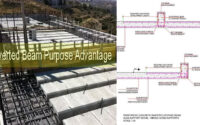What is Manholes – Importance, Purpose of Manholes, Types of Manholes
What is Manholes
Manholes are the most typical underground structures used by maintenance utilities to enable access to installed pipelines for inspection and cleaning. It’s an important part of the water and sewage systems, as well as the basic subsurface utilities. On the streets and paved walks, manholes are a common sight.
Manhole covers are coverings that cover open manholes to prevent people from tripping over them or illegal persons from entering. We may walk over them on a daily basis, but we rarely consider the significance of manhole covers in our lives. Manhole cover manufacturers in India are well-known throughout the world for their high-quality products. According to a survey, the majority of manhole covers in the United States are imported from India. The government’s Make in India strategy has helped manufacturers reach new heights. Manhole covers have provided an outlet for people to express their artistic skills in some nations, such as Japan, where colourful manhole covers can be found everywhere.
Importance of Manholes
Manholes are frequently used to link two or more water supply or sanitary sewage lines. Drainage systems in today’s cities and towns are full of pipes and tunnels that run beneath the roadways and pavements. The manhole entry must be different diameters, angles, and heights depending on the use. A manhole cover is necessary to adequately cover these channels with a detachable plate.
The majority of the time, manholes are used for maintenance purposes. Manhole coverings will keep unauthorised individuals out and prevent anything or anyone from falling into the hole. Manhole covers may appear to be a basic plate or lid covering a large hole, but they are made using a variety of patterns and techniques.
Manhole cover manufacturers keep up with current trends and design manhole covers that use cutting-edge technology. They aim to suit the needs of consumers, as each application’s goal vary.

Purposes of Manhole
- They are used to perform sewer line inspections, cleaning, and obstacle removal.
- Manholes allow sewers to be joined, or sewers to be changed in direction or alignment, or both.
- They allow a significant amount of gas to escape via the perforated lid, assisting in sewage ventilation.
- They make it easier to lay sewer line in manageable lengths.
Features of Manhole
The chamber or ring and the Vertical Circular Pipe are the two primary components of a manhole. Vertical circular pipes come in a variety of depths and sizes. These pipes are utilised to gain access to the system’s inspection joints.
Manholes are typically placed 0.5 metres from the road’s curb lines. The majority of the time, it is built away from the traffic’s wheel line.
A manhole cover is a stopper that prevents unauthorised access to the manhole. Manhole covers come in a variety of shapes, including rectangular, square, and circular. Precast concrete, composite materials, or any glass-reinforced plastic material can be used for the cover.
The provision for access through the manhole is accomplished in a series of phases. A step ladder is built if the depth of the manhole is less than 1 m. A conventional ladder is installed if the manhole depth is larger than 2.5m. Modern manholes no longer require physical access.
Types of Manhole
Depending on the depth, there are three basic types of manholes:
- Shallow Manhole
- Normal Manhole
- Deep Manhole
1. Shallow Manholes
These manholes have a shallow depth of two to three feet (75-90 centimetres). They are usually installed at the beginning of a sewer or drainage water conduit route and in regions where there isn’t a lot of traffic. These are also known as inspection chambers with a light lid as a cover and are excellent for maintenance work.
2. Normal Manhole
It is installed at a depth of 150cm in a sewage line with a hefty cover on top. It is usually square in shape (or rectangular shape).
3. Deep Manhole
At a depth of more than 150 cm, a deep manhole with a heavy cover on the upper surface is supplied. In addition, the manhole’s depth has been expanded, as has the ability to descend down it.





